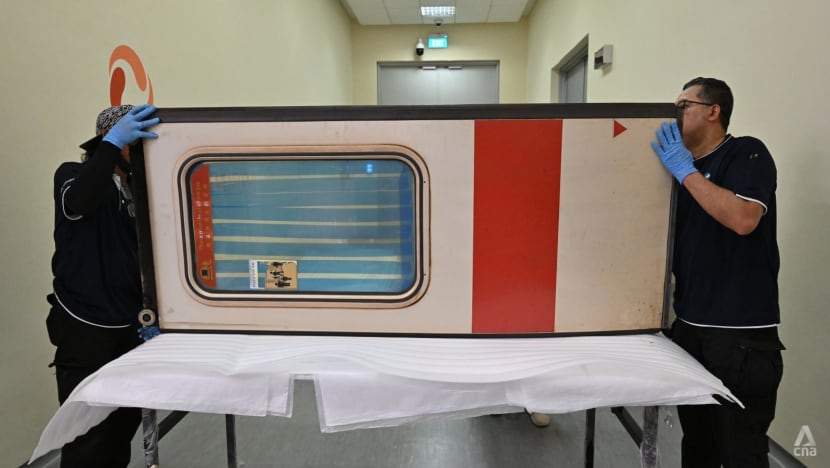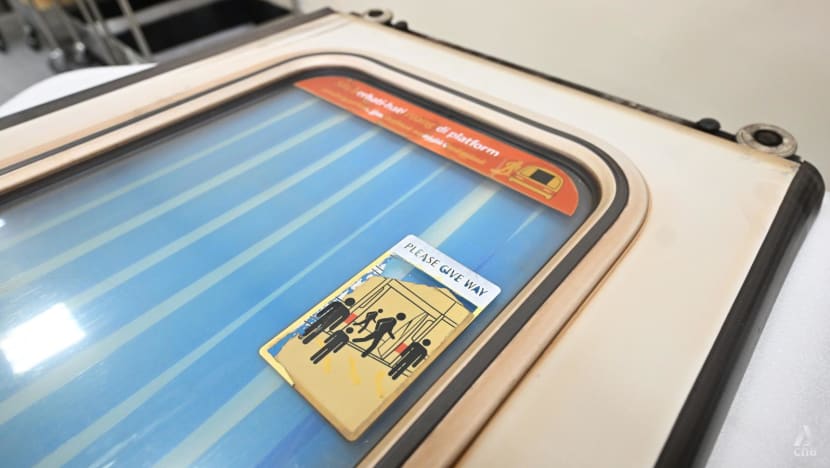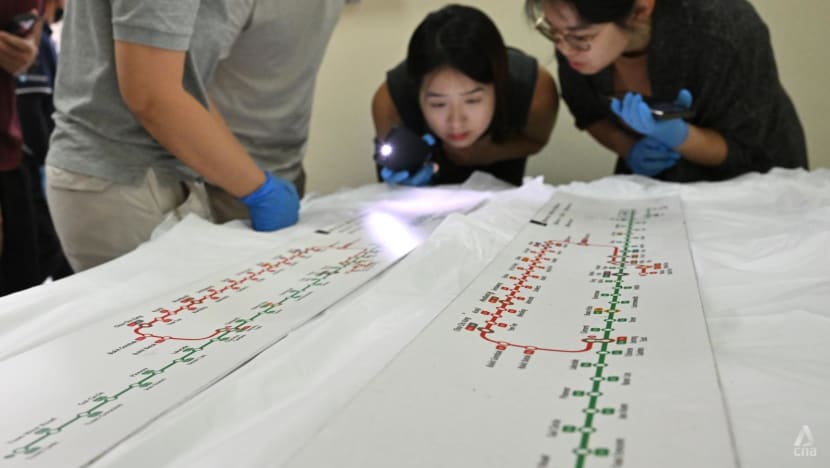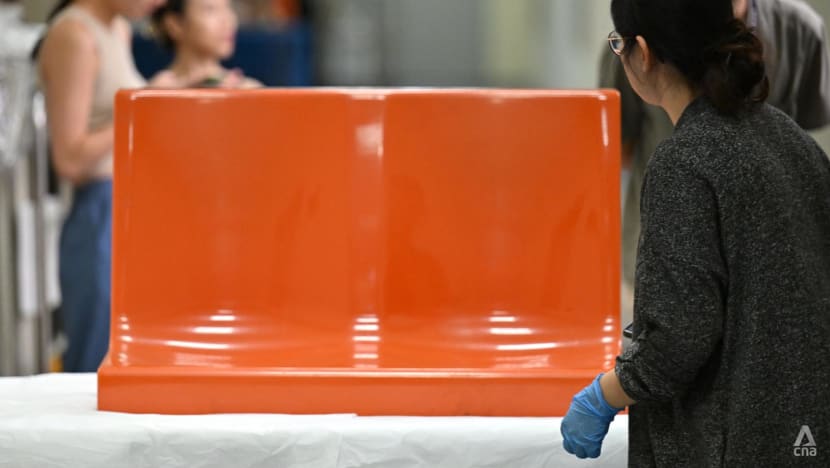Doors, seats and map displays from 1990s MRT train to be preserved by National Museum
The train parts were preserved due to their social and historical significance in Singapore’s rapid growth during the 80s and 90s, said the National Museum.

SMRT's early-generation MRT train door being inspected before storage after being acquired by the National Museum of Singapore as part of the Collecting Contemporary Singapore initiative. (Photo: CNA/Jeremy Long)

This audio is generated by an AI tool.
SINGAPORE: Commuters who miss the look and feel of early-generation MRT trains launched in the 1990s can look forward to parts of these trains, such as doors and seats, being displayed at exhibitions.
For the first time, the National Museum of Singapore (NMS) is preserving parts of a decommissioned MRT train in light of its historical value and national significance.
Two sets of train doors, a pair of seats, and two MRT train system map displays have been acquired by NMS in collaboration with transport operator SMRT and the Land Transport Authority (LTA).
This is under the “Collecting Contemporary Singapore” initiative started by NMS together with the National Heritage Board in 2020.
Assistant curator for design at the NMS Samuel Lee said that the initiative seeks to identify important parts of Singapore’s contemporary social history.
“We do see the MRT as something quite important in terms of historical and emotional significance in Singapore because it represents the development of Singapore’s nation building progress and rapid modernisation in the 80s and 90s,” he said.
He added that this is the first time that train parts are entering the national collection.
Earlier this year, NMS acquired an old lift at Ang Mo Kio and an old Nanyang coffee roasting machine to add to its collection.
Mr Lee said that artefacts under this initiative are chosen based on their historical and social significance.
“If it really speaks to national identity (and) collective memories of Singaporeans, with people riding the trains as children and then growing up with the transportation network, that speaks to the collective memory of Singaporeans,” he said.
HOW PARTS ARE PRESERVED
The train parts were from a second-generation SMRT Siemens C651 train that was built in 1992, and decommissioned around February this year.
The six-car trains were introduced to the MRT system from 1994 to 1996 and served the North-South and East-West MRT lines before they started being decommissioned in 2020.
Mr Lee said that the specific train model is the last of its kind to feature the iconic white and red livery, as many older trains have been refurbished.
Members of the media were present as the train parts were transported from its storage space at Tuas Depot to the Heritage Conservation Centre at Jurong Port Rd.
Wrapped in protective bubble wrap, the parts were taken out of a truck and into the conservation centre for its condition to be assessed by staff.
For instance, the two sets of train doors - which comprise four train door panels - were carefully taken out of their protective wrapping and put on a table for staff to examine.
The corners of the MRT system map display was also closely inspected by staff. The display was considered modern given the trains' recent decommissioning, and showed the East-West Line and North-South Line with new interchanges, such as where the Thomson East-Coast Line meets Outram Park.


For the pair of iconic orange MRT seats, a sticker at the back of the seat had information on it in German.
On the German language, Mr Lee explained that the entire train was built in Vienna, Austria.
The parts will go through a fumigation process to kill potential pests that could be present in the carriage, before being assessed for its display potential.

TRAIN PARTS CHOSEN FOR THEIR "DISPLAY POTENTIAL"
As for when members of the public can expect to see the items, Mr Lee said that this is still being assessed.
“The intent is that everything we collect will eventually be displayed or shown at some point, maybe not in the immediate future, but for a potential exhibition,” he said.
On why several train parts rather than the whole train carriage were preserved, Mr Lee said that it boils down to the “display potential” of the items.
“We want to ensure that when we collect something, we can sensibly display it in the future, so there is a higher likelihood of bringing it into an exhibition if it’s these components.”
He added that the components that are being preserved also happen to be “things people most strongly identify with when they think of the train”.
This is as opposed to other parts of the train such as its motor components that are out of commuters’ sight.
Separately, the LTA said that it has issued a public call for organisations or institutions interested in adopting train cars or parts from their decommissioned trains.
This is part of LTA's sustainability efforts to give decommissioned first-generation trains on the North-South and East-West line a "new lease of life", said its spokesperson.
LTA has so far worked with educational institutions as well as non-profit organisations to upcycle various train parts.
Parties interested in acquiring retired trains or upcycling train parts can email LTA at LTA_Train_Repurpose [at] lta.gov.sg for more information.
















